“Cavor, this is not an audience! You’re on trial!” — Arnold Bedford to Joseph Cavor
In 1964, a rocket launched by the United Nations has landed on the moon. Three international astronauts soon discover they are not the first. Found on a rock are a faded British Union Jack and a note: “Claimed for Her Majesty Queen Victoria in the Year of Our Lord, 1899.” Strangely, the declaration is on the back of a legal contract for the sale of a house in Dymchurch, England, signed by a Katherine Callender.
First Men in the Moon, tenuously based on H. G. Wells’ 1901 science fiction novel, is full of astronomical errors as well as a ridiculous premise, that a painted-on chemical liquid, when dry, can negate the force of gravity. The eccentric scientist of the book has been turned into a comic figure (Lionel Jeffries), and a woman (Martha Hyer) has been added for romantic interest, a ploy that also weakened Mysterious Island, it with two women, four years earlier.
Jeffries, the third-listed player in the credits, is, by far, the star of the film, given that his physical gyrations and repeated-word speech, both effected in rapid, staccato assaults, are sometimes annoying. In much the same way, Hyer, the only American in an otherwise British/Canadian/Australian cast, quickly becomes gratingly intrusive.
 Edward Judd, the actual top-listed star, the supposed romantic lead, is often irritated, like the audience, by Hyer’s presence, and he doesn’t do much “romancing” or “leading” with her, except to say, “Kate!,” in exasperation, perhaps sensing she’s a script burden. Judd never considered himself, as he said, “a leading man type” and preferred playing the heavy. Born in Shanghai, China, of British parents, he is thoroughly British, however, and like another Brit of similar demeanor, Michael Craig (in Mysterious Island), he is not particularly well known to American audiences.
Edward Judd, the actual top-listed star, the supposed romantic lead, is often irritated, like the audience, by Hyer’s presence, and he doesn’t do much “romancing” or “leading” with her, except to say, “Kate!,” in exasperation, perhaps sensing she’s a script burden. Judd never considered himself, as he said, “a leading man type” and preferred playing the heavy. Born in Shanghai, China, of British parents, he is thoroughly British, however, and like another Brit of similar demeanor, Michael Craig (in Mysterious Island), he is not particularly well known to American audiences.
Despite the factual errors, the deviations from the novel and other variants, First Men in the Moon is an enjoyable, even fun movie. Its special effects by Ray Harryhausen, if impressive in their time, are embryonic compared with the sophisticated work to come in Star Wars (1977) and, more so, in its successors.
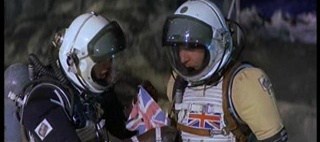 In the opening, the moon arrival of the astronauts is sometimes comically naïve. The men walk the surface of the moon as they would on Earth, irrespective of the much weaker gravity on the moon, and the spacecraft’s communication with the mother-ship is simplistic. But for the second half of the film, the sets for the below-surface world of the moon inhabitants are on a higher level, often magical, and the creatures themselves are both creepy and fascinating in Harryhausen’s stop-action jerkiness.
In the opening, the moon arrival of the astronauts is sometimes comically naïve. The men walk the surface of the moon as they would on Earth, irrespective of the much weaker gravity on the moon, and the spacecraft’s communication with the mother-ship is simplistic. But for the second half of the film, the sets for the below-surface world of the moon inhabitants are on a higher level, often magical, and the creatures themselves are both creepy and fascinating in Harryhausen’s stop-action jerkiness.
The music is feeble alongside what could have been a score by Bernard Herrmann had he not asked for so much money that second-stringer Laurie Johnson was chosen. In the late 1950s and early ’60s Herrmann was in the midst of a series of fantasy milestones in film scoring, all with Harryhausen special effects—The Seventh Voyage of Sinbad, The Three Worlds of Gulliver, Mysterious Island and Jason and the Argonauts—so the arrogant composer must have felt he was worth every bit of his exorbitant asking price. He probably would have been, and First Men in the Moon is weaker because of his absence. To give Johnson the credit due him, he is suitably whimsical or romantic in the film’s first third, and, within the confines of his own approach, heavy, ponderous and static in the main title and in the moon scenes.
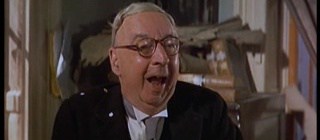 With the moon landing, a U.N. Space Agency investigation team and television and newspaper reporters descend on the registry of Dymchurch. The befuddled clerk (Miles Malleson, a master of screen befuddlement), after unsuccessfully searching the birth records for a Katherine Callender (Hyer), suddenly remembers that he married her, though she had died some years ago.
With the moon landing, a U.N. Space Agency investigation team and television and newspaper reporters descend on the registry of Dymchurch. The befuddled clerk (Miles Malleson, a master of screen befuddlement), after unsuccessfully searching the birth records for a Katherine Callender (Hyer), suddenly remembers that he married her, though she had died some years ago.
Her surviving husband, Arnold Bedford (Judd), lives in a nursing home outside Dymchurch. When he is shown photos of the tattered Union Jack and the note, he says, “You found them on the moon, didn’t you?” It is Judd’s finest acting in the film, aided by wire-rim glasses and an aged face; the makeup is by Colin Garde, who is the uncredited second artist for Oliver Reed’s facial metamorphosis in Hammer Films’ The Curse of the Werewolf (1961).
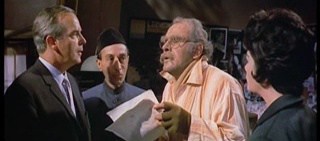 After warning the reporters that the moon expedition is in great danger, Bedford draws a shawl around his shoulders and begins: “Eighteen ninety-nine—it’s so long ago. I’d been . . . I’d been engaged in an unsuccessful business regulation. To be frank, my creditors were pressing me hard.” He explains, that as a playwright, he was looking for a secluded place to write. “In the end, I rented a cottage up near Dymchurch. I remember . . . I remember, it was along that bend in the canal . . . ”
After warning the reporters that the moon expedition is in great danger, Bedford draws a shawl around his shoulders and begins: “Eighteen ninety-nine—it’s so long ago. I’d been . . . I’d been engaged in an unsuccessful business regulation. To be frank, my creditors were pressing me hard.” He explains, that as a playwright, he was looking for a secluded place to write. “In the end, I rented a cottage up near Dymchurch. I remember . . . I remember, it was along that bend in the canal . . . ”
And a flashback begins for most of the rest of the movie——
In the late 1890s, Callender, an American, arrives for the first time at Cherry Cottage, the newly rented home of her fiancé, would-be playwright Bedford. While Bedford is upstairs, Joseph Cavor (Jeffries) comes to the house. Having been bicycling to his own nearby home and seeing first-time smoke from the cottage’s chimney, he stops to investigate.
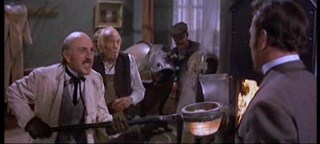 “I’m a research scientist,” he proudly tells Katherine. “I’m on the point of . . . probably one of the most important scientific demonstrations of all time.” Their conversation is abruptly interrupted. “The furnace!” he cries. “The furnace! Gibbs! Gibbs!” He dashes out of the house.
“I’m a research scientist,” he proudly tells Katherine. “I’m on the point of . . . probably one of the most important scientific demonstrations of all time.” Their conversation is abruptly interrupted. “The furnace!” he cries. “The furnace! Gibbs! Gibbs!” He dashes out of the house.
“You forgot your bicycle!” she calls after him, as he runs across an adjacent field.
“Yes, yes, I have a bicycle—that’s quite right. Yes. Gibbs! Gibbs!”
Bedford follows after him in one of those newfangled motor cars, not so much to return the bicycle as to cancel Katherine’s impulsive deal to sell Cherry Cottage. Having first met Cavor’s handyman Gibbs (Erik Chitty), he finds the mad scientist—for he seems just that—removing some sort of molten substance from the furnace.
It’s Cavorite, an ingredient that, when dry, will deflect the force of gravity. To demonstrate, Cavor applies it to the underside of a chair, and, with Bedford sitting in it, man and chair rise to the ceiling. Bedford thinks the stuff would be great for coating the soles of his army surplus boots from the Boer War, one of his business ventures gone awry, but Cavor, who is fighting a cold, thinks somewhat bigger . . . a trip to the moon.
Bedford has Katherine sign a contract to sell Cherry Cottage to Cavor, otherwise, he explains, his signature would only attract his creditors. Bedford plans to invest the money in Cavor’s experiments, only to find that the inventor was serious about the moon.
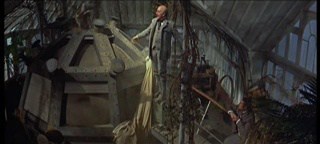 Cavor has built a spherical spaceship from scrap steel girders and railroad buffers. It’s in an old greenhouse, “guarded” by his pet geese and sealed to maintain a temperature of at least 123 degrees, the heat provided from the furnace. The launch day having arrived, the heat keeps the Cavorite moist until Cavor has coated all of the numerous retractable shutters. Covering and uncovering the shutters can supposedly alter the trajectory of the sphere in space.
Cavor has built a spherical spaceship from scrap steel girders and railroad buffers. It’s in an old greenhouse, “guarded” by his pet geese and sealed to maintain a temperature of at least 123 degrees, the heat provided from the furnace. The launch day having arrived, the heat keeps the Cavorite moist until Cavor has coated all of the numerous retractable shutters. Covering and uncovering the shutters can supposedly alter the trajectory of the sphere in space.
Meanwhile, Katherine is served with a subpoena for having illegally sold Cherry Cottage. Angry, subpoena in hand, she enters the greenhouse, its doors open, the furnace shut down. The Cavorite is slowly hardening. Cavor and Bedford are hunkered down in the sphere, prepared for an imminent blast off.
Cavor instructs Bedford to intertwine his arms and hands through a vertical hammock-like net, because “There might be a violent shock coming.” He tenses up. “Any moment now—I feel it.” It’s then that Katherine bangs on the hatch of the sphere. “We’re off!” he cries. Then Katherine shouts forBedford to come out. “That woman!” Cavor exclaims. “That woman! She’s impossible. She’ll be blasted to death!”
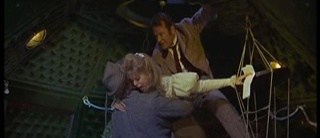 Bedford pulls her through the hatch and inside seconds before the sphere crashes through the greenhouse roof and rockets into space. After a few comic routines and a surprisingly short voyage through space, the sphere strikes the moon at an angle and rolls across the surface before coming to a stop. Cavor and Bedford leave the sphere, attired in deep-sea diving suits—“What keeps water out, keeps air in,” Cavor had reasoned. Katherine is safe in an air-tight compartment.
Bedford pulls her through the hatch and inside seconds before the sphere crashes through the greenhouse roof and rockets into space. After a few comic routines and a surprisingly short voyage through space, the sphere strikes the moon at an angle and rolls across the surface before coming to a stop. Cavor and Bedford leave the sphere, attired in deep-sea diving suits—“What keeps water out, keeps air in,” Cavor had reasoned. Katherine is safe in an air-tight compartment.
Having posted the Union Jack and the document claiming the moon for Victoria, the two new arrivals hear (not likely in their circumstance!) a rumbling and discover metal doors moving back from a giant transparent glass. The two men accidentally fall through the glass and down a deep shaft.
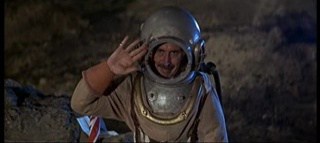 Here, beneath the surface of the moon, they discover insectoids, human-size creatures much like grasshoppers walking on their hind legs. Cavor calls them Selenites, after the Greek goddess of the moon, Selene. The beings manufacture their own atmosphere, which, luckily for the two explorers, is identical to oxygen on Earth.
Here, beneath the surface of the moon, they discover insectoids, human-size creatures much like grasshoppers walking on their hind legs. Cavor calls them Selenites, after the Greek goddess of the moon, Selene. The beings manufacture their own atmosphere, which, luckily for the two explorers, is identical to oxygen on Earth.
Something of an inconvenience, the Selenites exist only when it’s daylight on the moon’s surface. A great, revolving crystal disc reflects sunlight down the shaft and throughout the underground caverns. When the sun sets, the Selenites go into a comatose state, only revived when dawn comes; it perhaps never occurred to them—why not built a second crystal and dig a second tunnel on the other side of the moon?
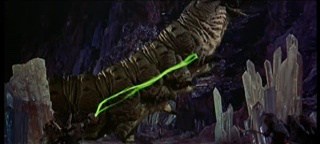 At one point, the two earthlings are attacked by a giant caterpillar, or mooncalf as H. G. Wells called it, and the Selenites kill it with an electric ray gun. The Grand Lunar (Luna is the Roman moon goddess) almost instantly assimilates English, and Cavor, feeling this leader of the moon beings is simply curious, answers its questions about life on Earth. The insectoid is amazed that endless wars are practiced there. Bedford warns his friend that he is on trial, that the Selenites have no intention of letting them go.
At one point, the two earthlings are attacked by a giant caterpillar, or mooncalf as H. G. Wells called it, and the Selenites kill it with an electric ray gun. The Grand Lunar (Luna is the Roman moon goddess) almost instantly assimilates English, and Cavor, feeling this leader of the moon beings is simply curious, answers its questions about life on Earth. The insectoid is amazed that endless wars are practiced there. Bedford warns his friend that he is on trial, that the Selenites have no intention of letting them go.
Selenite workers have dragged the sphere into the underground and have begun dismantling it. Katherine, in the sphere all this time because Cavor had not anticipated the need for a third diving suit, helps Bedford reassemble the spacecraft after he decides they must escape. Cavor convinces them to return to Earth without him, that the discovery of this new species, and the exchange of knowledge, is too important to pass up.
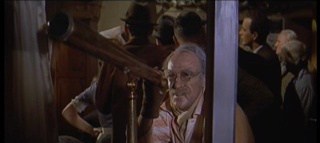 Back now in 1964, the aged Arnold Bedford is concluding his story to the reporters gathered at his retirement home. The sphere, he says, landed in the sea off of Zanzibar, and he and Katherine swam ashore. Then everyone’s attention in the room is drawn to a new development in the moon landing coverage on television. Just as the astronauts reach the interior city on the moon, it begins to crumble, and the newscaster observes “corrosion and decay” and surmises what had happened . . . possibly “creatures without immunity.”
Back now in 1964, the aged Arnold Bedford is concluding his story to the reporters gathered at his retirement home. The sphere, he says, landed in the sea off of Zanzibar, and he and Katherine swam ashore. Then everyone’s attention in the room is drawn to a new development in the moon landing coverage on television. Just as the astronauts reach the interior city on the moon, it begins to crumble, and the newscaster observes “corrosion and decay” and surmises what had happened . . . possibly “creatures without immunity.”
Bedford, his shawl still wrapped around his shoulders, steps to the window and peers through his telescope at the moon. “Poor Cavor. He did have such a terrible cold.”
